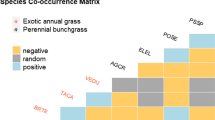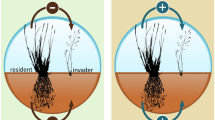Abstract
Several factors may influence invasive spread dynamics once a species becomes naturalized. Propagule pressure generated from established populations is likely mediated by local scale factors such as plant community characteristics and disturbance regimes as well as ecosystem scale factors such as landscape features that shape dispersal patterns and propagule availability. Using a multi-scale observational approach, we explore how propagule pressure generated from naturalized populations of Anthriscus caucalis (M.-Bier) influences invasive spread dynamics in the Snake River canyon grassland ecosystem of the Intermountain Pacific Northwest, USA. In this study, we utilize demographic insights into A. caucalis naturalization across plant communities and a companion ecosystem scale distribution survey to elucidate invasive spread dynamics using spatially-explicit SDMs. We modeled A. caucalis occurrence as a function of plant community type, grazing disturbance, and propagule pressure generated from high-shrub communities. A. caucalis was almost uniformly present in low- and high-shrub (>90 %) communities. Within bunchgrass communities, A. caucalis occurrence was significantly lower within grazed paddocks (3 %) compared to ungrazed paddocks (52 %). The probability of A. caucalis occurrence in bunchgrass communities within ungrazed paddocks also increased at a faster rate as the relative area of high-shrub communities increased. These results suggest propagule pressure generated from high-shrub communities strongly influence invasive spread into bunchgrass communities. Our results also suggest that livestock disturbance slows invasive spread by decreasing propagule supply from high-shrub communities. Plant community composition also contributed to A. caucalis occurrence patterns within bunchgrass communities. A. caucalis occurrence declined as native bunchgrass cover increased, whereas occurrence increased with increasing cover of exotic annual species. As native bunchgrass cover declined, A. caucalis occurrence increased in locations with greater relative area of high-shrub communities. These results suggest that undisturbed bunchgrass communities are resistant to A. caucalis invasion regardless of propagule supply. In disturbed bunchgrass communities dominated by exotic annuals, A. caucalis invasion levels were positively associated with increased propagule pressure generated from high-shrub communities. In conclusion, the coupling of comparative demographic observations with spatially-explicit SDMs yielded significant insights into invasive spread dynamics. This approach should be applicable for elucidating invasive spread dynamics of other invading plant species and ecosystems.





Similar content being viewed by others
References
Brown KA, Spector S, Wu W (2008) Mult-scale analysis of species introductions: combining landscape and demographic models to improve management decisions about non-native species. J Appl Ecol 45:1639–1648
Burnham KP, Anderson DR (2002) Model selection and multi-model inference: a practical information-theoretic approach. Springer, New York
Castro SA, Badano E, Guzman D, Cavieres L (2010) Biological invasion of a refuge habitat: Anthriscus caucalis (Apiaceae) decreases diversity, evenness, and survival of native herbs in the Chilean matorral. Biol Invasions 12:1295–1303
Chytrỳ M, Jaroŝik V, Pyŝek P, Hájek O, Knollová I, Tichỳ L, Danihelka J (2008) Separating habitat invasibility by alien plants from the actual level of invasion. Ecology 89(6):1541–1553
Congalton RG, Mead RA (1983) A quantitative method to test for consistency and correctness in photointerpretation. Photogramm Eng Remote Sens 49:69–74
Daubenmire RF (1942) An ecological study of the vegetation of southeastern Washington and adjacent Idaho. Ecol Mongr 12:53–79
Davis MA, Grime JP, Thompson K (2000) Fluctuating resources in plant communities: a general theory of invasibility. J Ecol 88:528–534
Enloe SF, DiTomaso JM, Orloff SB, Drake DJ (2004) Soil water dynamics differ among rangeland plant communities dominated by yellow starthistle (Centaurea solstitialis), annual grasses, or perennial grasses. Weed Sci 52:929–935
Eschtruth AK, Battles JJ (2009) Assessing the relative importance of disturbance, herbivory, diversity and propagule pressure in exotic plant invasion. Ecol Monographs 79(2):265–280
Eschtruth AK, Battles JJ (2011) The importance of quantifying propagule pressure to understand invasion: an examination of riparian forest invasibility. Ecol 92:1314–1322
Fensham RJ, Donald S, Dwyer JM (2013) Propagule pressure, not fire or cattle grazing, promotes invasion of buffel grass (Cenchrus ciliaris). J Appl Ecol 50:138–146
Fortin MJ, Dale MR (2005) Spatial analysis: a guide for ecologists. Cambridge University Press, Cambridge
Foxcroft LC, Rouget M, Richardson DM, MacFadyen S (2004) Reconstructing fifty years of Opuntia stricta invasion in the Kruger National Park: environmental determinants and propagule pressure. Divers Distrib 10:427–437
Gonzẚlez-Moreno P, Pino J, Carreras D, Basnou C, Fernẚndez-Rebollar Vilẚ M (2013) Quantifying the landscape influence on plant invasions in Mediterranean coastal habitats. Landsc Ecol 28:891–903
Grime JP (1998) Benefits of plant diversity to ecosystems: immediate, filter and founder effects. J Ecol 86:902–910
Gurevitch J, Fox GA, Wardle GM, Inderjit Taub D (2011) Emergent insights from the synthesis of conceptual frameworks for biological invasions. Ecol Lett 14:407–418
Johnson CG, Simon SA (1987) Plant associations of the Wallowa-snake river province. USDA-forest service-pacific northwest region R6-ECOL-TP-255A-86
Mack RN (1989) Temperate grasslands vulnerable to plant invasions: characteristics and consequences. In: Drake JA (ed) Biological invasions: a global perspective. Wiley, Hoboken, pp 155–179
McClain CD, Holl KD, Wood DM (2011) Successional models as guides for restoration of riparian forest understory. Restor Ecol 19:280–289
Nakagawa S, Schielzeth H (2013) A general and simple method for obtaining R2 from generalized linear mixed-effects models. Methods Ecol Evol 4:133–142
Rice P (2011) Anthriscus caucalis. Invaders database system. http://invader.dbs.umt.edu. Accessed 15 Dec 2011
Richardson DM, Pyŝek P (2012) Naturalization of introduced plants: ecological drivers of biogeographical patterns. New Phytol 196:383–396
Richardson DM, Pyŝek P, Rejmẚnek M, Barbour MG, Panetta DF, West CJ (2000) Naturalization and invasion of alien plants: concepts and definitions. Divers Distrib 6:713–724
Rouget M, Richardson DM (2003) Inferring process from pattern in alien plant invasions: a semi-mechanistic model incorporating propagule pressure and environmental factors. Am Nat 164:713–724
Seastedt TR, Pyšek P (2011) Mechanisms of plant invasions of North American and European grasslands. Ann Rev Ecol Evol Syst 42:133–153
Simberloff D (2009) The role of propagule pressure in biological invasions. Annu Rev Ecol Evol Syst 40:81–102
Spalik K (1996) Species boundaries, phylogenetic relationships, and ecological differentiation in Anthriscus (Apiaceae). Pl Syst Evol 199:17–32
Thomas SM, Moloney KA (2015) Combining the effects of surrounding land-use and propagule pressure to predict the distribution of an invasive plant. Biol Invasions 17:477–495
Vilẚ M, Ibẚñez I (2011) Plant invasions in the landscape. Landsc Ecol 26:4641–4721
Wallace JM, Prather TS (2013) Comparative demography of an exotic herbaceous annual among plant communities in invaded canyon grassland: inferences for habitat suitability and population spread. Biol Invasions 15:2783–2797
Wiens JJ, Graham CH (2005) Niche conservatism: integrating evolution, ecology and conservation biology. Annu Rev Ecol Evol Syst 36:519–539
With KA (2004) Assessing the risk of invasive spread in fragmented landscapes. Risk Anal 24:803–815
Author information
Authors and Affiliations
Corresponding author
Rights and permissions
About this article
Cite this article
Wallace, J.M., Prather, T.S. Invasive spread dynamics of Anthriscus caucalis at an ecosystem scale: propagule pressure, grazing disturbance and plant community susceptibility in canyon grasslands. Biol Invasions 18, 145–157 (2016). https://doi.org/10.1007/s10530-015-0997-x
Received:
Accepted:
Published:
Issue Date:
DOI: https://doi.org/10.1007/s10530-015-0997-x




